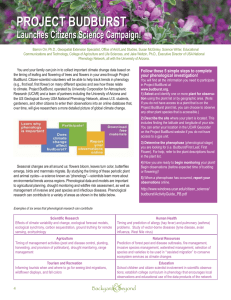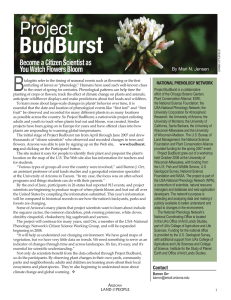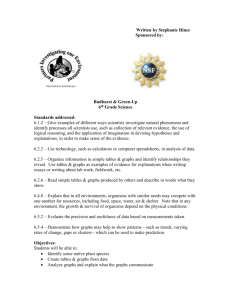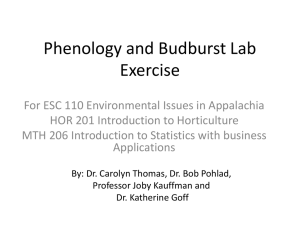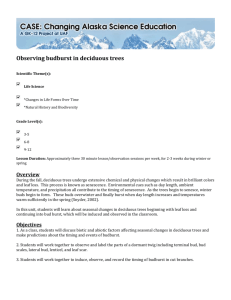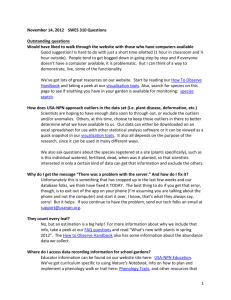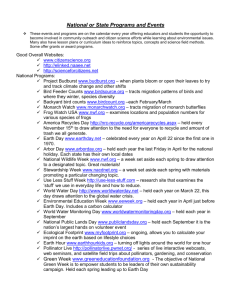Incorporating budburst Pseudotsuga Peter
advertisement
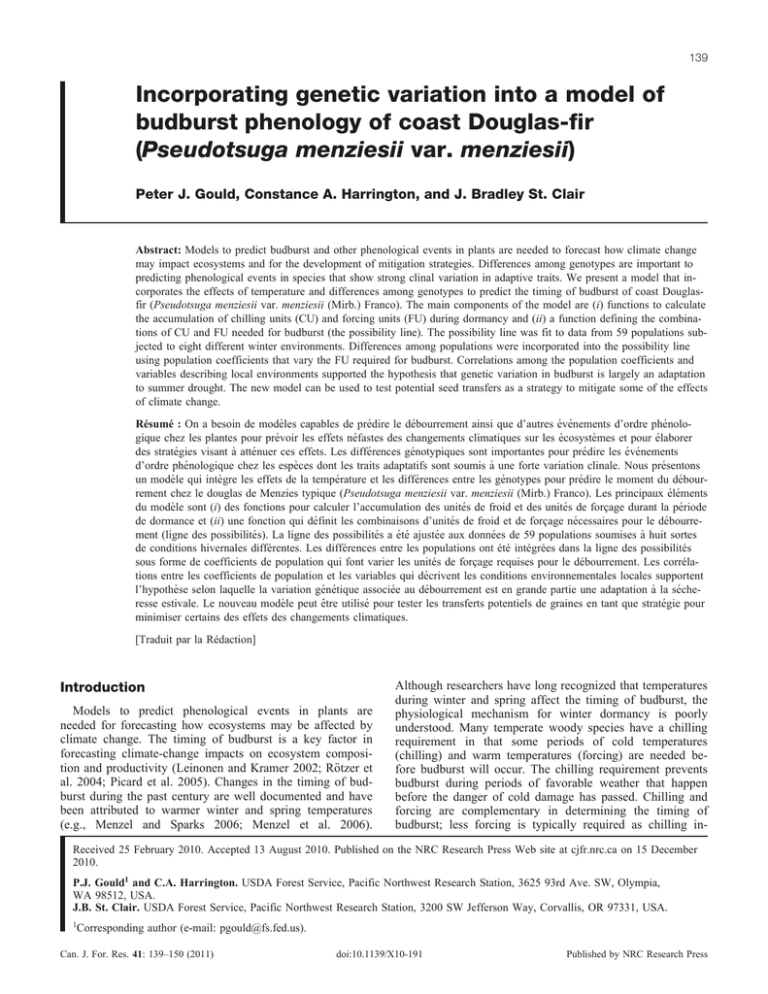
139 Incorporating genetic variation into a model of budburst phenology of coast Douglas-fir (Pseudotsuga menziesii var. menziesii) Peter J. Gould, Constance A. Harrington, and J. Bradley St. Clair Abstract: Models to predict budburst and other phenological events in plants are needed to forecast how climate change may impact ecosystems and for the development of mitigation strategies. Differences among genotypes are important to predicting phenological events in species that show strong clinal variation in adaptive traits. We present a model that in­ corporates the effects of temperature and differences among genotypes to predict the timing of budburst of coast Douglasfir (Pseudotsuga menziesii var. menziesii (Mirb.) Franco). The main components of the model are (i) functions to calculate the accumulation of chilling units (CU) and forcing units (FU) during dormancy and (ii) a function defining the combina­ tions of CU and FU needed for budburst (the possibility line). The possibility line was fit to data from 59 populations sub­ jected to eight different winter environments. Differences among populations were incorporated into the possibility line using population coefficients that vary the FU required for budburst. Correlations among the population coefficients and variables describing local environments supported the hypothesis that genetic variation in budburst is largely an adaptation to summer drought. The new model can be used to test potential seed transfers as a strategy to mitigate some of the effects of climate change. Résumé : On a besoin de modèles capables de prédire le débourrement ainsi que d’autres événements d’ordre phénolo­ gique chez les plantes pour prévoir les effets néfastes des changements climatiques sur les écosystèmes et pour élaborer des stratégies visant à atténuer ces effets. Les différences génotypiques sont importantes pour prédire les événements d’ordre phénologique chez les espèces dont les traits adaptatifs sont soumis à une forte variation clinale. Nous présentons un modèle qui intègre les effets de la température et les différences entre les génotypes pour prédire le moment du débour­ rement chez le douglas de Menzies typique (Pseudotsuga menziesii var. menziesii (Mirb.) Franco). Les principaux éléments du modèle sont (i) des fonctions pour calculer l’accumulation des unités de froid et des unités de forçage durant la période de dormance et (ii) une fonction qui définit les combinaisons d’unités de froid et de forçage nécessaires pour le débourre­ ment (ligne des possibilités). La ligne des possibilités a été ajustée aux données de 59 populations soumises à huit sortes de conditions hivernales différentes. Les différences entre les populations ont été intégrées dans la ligne des possibilités sous forme de coefficients de population qui font varier les unités de forçage requises pour le débourrement. Les corréla­ tions entre les coefficients de population et les variables qui décrivent les conditions environnementales locales supportent l’hypothèse selon laquelle la variation génétique associée au débourrement est en grande partie une adaptation à la séche­ resse estivale. Le nouveau modèle peut être utilisé pour tester les transferts potentiels de graines en tant que stratégie pour minimiser certains des effets des changements climatiques. [Traduit par la Rédaction] Introduction Models to predict phenological events in plants are needed for forecasting how ecosystems may be affected by climate change. The timing of budburst is a key factor in forecasting climate-change impacts on ecosystem composi­ tion and productivity (Leinonen and Kramer 2002; Rötzer et al. 2004; Picard et al. 2005). Changes in the timing of budburst during the past century are well documented and have been attributed to warmer winter and spring temperatures (e.g., Menzel and Sparks 2006; Menzel et al. 2006). Although researchers have long recognized that temperatures during winter and spring affect the timing of budburst, the physiological mechanism for winter dormancy is poorly understood. Many temperate woody species have a chilling requirement in that some periods of cold temperatures (chilling) and warm temperatures (forcing) are needed be­ fore budburst will occur. The chilling requirement prevents budburst during periods of favorable weather that happen before the danger of cold damage has passed. Chilling and forcing are complementary in determining the timing of budburst; less forcing is typically required as chilling in- Received 25 February 2010. Accepted 13 August 2010. Published on the NRC Research Press Web site at cjfr.nrc.ca on 15 December 2010. P.J. Gould1 and C.A. Harrington. USDA Forest Service, Pacific Northwest Research Station, 3625 93rd Ave. SW, Olympia, WA 98512, USA. J.B. St. Clair. USDA Forest Service, Pacific Northwest Research Station, 3200 SW Jefferson Way, Corvallis, OR 97331, USA. 1Corresponding author (e-mail: pgould@fs.fed.us). Can. J. For. Res. 41: 139–150 (2011) doi:10.1139/X10-191 Published by NRC Research Press 140 creases to an optimal level, after which additional chilling does not decrease the amount of forcing required for budburst (Campbell and Sugano 1979; Cannell and Smith 1983). Empirical models have proven useful for predicting budburst, and numerous models have been proposed for differ­ ent species (see review by Hänninen and Kramer 2007). Most models have been fit to phenological observations and meteorological records in a natural environment. Conclu­ sions about the relative merits of different models have been influenced by differences among species, the range of temperatures tested, the test environment (natural or con­ trolled temperatures), and model-fitting techniques (Hän­ ninen 1995; Chuine et al. 1998, 1999; Schaber and Badeck 2003). Chuine (2000) argued that many models are special cases of a unified general model of phenological develop­ ment. The unified model has three main components: (i) re­ sponse functions for the effects of temperature on bud dormancy, (ii) a defined period when temperature is effec­ tive, and (iii) a temperature-dependent threshold at which budburst occurs. Temperature response functions calculate the accumulation of chilling units (CU) and forcing units (FU) during the winter period. Harrington et al. (2010) eval­ uated temperature response curves for several species and argued that universal response curves could be used for dif­ ferent species. The period of effectiveness defines the start and end of the chilling and forcing periods and whether they are sequential (forcing begins after a fixed amount of chilling), parallel (chilling and forcing occur simultane­ ously), or alternating. The temperature-dependent threshold defines the combinations of CU and FU that result in budburst (termed the ‘‘possibility line’’ by Harrington et al. (2010)). Species clearly have different chilling requirements and, thus, different possibility lines (Morin et al. 2009), but few models have attempted to parameterize differences among populations within a species (Morin et al. 2008; Garcia-Mozo et al. 2009; Mimura and Aitken 2010). Douglas-fir (Pseudotsuga menziesii (Mirb.) Franco) is known to be closely adapted to its local environment, and populations show pronounced clines in many traits that are associated with environmental gradients (Campbell 1979; Rehfeldt 1989; St. Clair et al. 2005). The coast variety of Douglas-fir (Pseudotsuga menziesii var. menziesii (Mirb.) Franco) has a native range in western North America that spans from about 348N to 548N and elevations from sea level to 2300 m (Hermann and Lavender 1990). Although Douglas-fir grows under a wide range of conditions, the cli­ mate generally can be characterized as maritime or mediter­ ranean with cool wet winters and warm dry summers. Genetic variation among populations of Douglas-fir follows the major regional gradients of climate (e.g., temperature and precipitation) and geography (e.g., elevation, longitude, and latitude) (St. Clair et al. 2005). Considerable variation in both climate and genotypes also occurs within small geo­ graphical areas (Campbell 1979; Sorensen 1983; Loopstra and Adams 1989). Although clinal variation in Douglas-fir has been widely documented, few results have been incorpo­ rated into predictive models. Phenological models that in­ clude genetic variation would be useful for evaluating seed transfer strategies to mitigate some effects of climate change. Earlier studies did not have the benefit of climate Can. J. For. Res. Vol. 41, 2011 models (e.g., Daly et al. 1994; Rehfeldt 2006; Wang et al. 2006) that can predict values of climate variables for spe­ cific locations. Instead, many studies reported relationships with geographic and topographic variables that could be measured directly (e.g., elevation, latitude, distance from the ocean). Such variables are proxies for the suite of factors that characterize a local environment; however, climate var­ iables provide much more detailed and biologically relevant information. Additionally, models that are intended to pre­ dict the effects of climate change or to identify populations that are well adapted to future climates need to be formu­ lated to use climate variables as input. In this paper, we extend the possibility-line model of Har­ rington et al. (2010) to incorporate genetic variation in budburst requirements among populations of Douglas-fir. The main components of the model are equations to calculate CU and FU as functions of temperature and the possibility line that defines the combination of CU and FU that will re­ sult in budburst. CU and FU accumulate concurrently during the winter, and budburst occurs when the combination of CU and FU reaches (or exceeds) the possibility line. We ex­ tend that model here by introducing population coefficients that vary the FU needed for budburst for a given level of CU. We evaluate the adaptive significance of the population coefficients by relating them to differences among the local environments of the populations we tested. The relationships are viewed through three hypotheses that although not mutu­ ally exclusive, emphasize different aspects of the environ­ ment and provide a basis for evaluating some impacts of seed transfer and climate change. For these relationships, positive correlations mean that more FU are required for budburst (so that budburst occurs later relative to other pop­ ulations); negative correlations mean that fewer FU are re­ quired (and budburst occurs earlier). Summer drought Soil water typically becomes depleted during the dry summers that characterize the environment throughout much of the range of Douglas-fir. Early budburst is advanta­ geous to align the period of height growth with the period of low water stress (White 1987; Joly et al. 1989). This hypoth­ esis would be supported by positive correlations between the population coefficients and measures of precipitation (e.g., annual precipitation and precipitation during the growing season) and negative correlations with temperatures during the summer months. Under this hypothesis, we also pre­ dicted positive correlations with soil variables that indicate greater water-holding capacity, which would help to delay the onset of summer drought (i.e., high silt or clay content and low sand content). Frost avoidance Delaying budburst in the spring reduces the risk of cold injury to new growth. Additionally, the timing of budburst is correlated with the period when older needles and other tissues ‘‘de-harden’’ and become susceptible to cold injury (Aitken and Adams 1997). This hypothesis would be sup­ ported by a positive correlation between the population coef­ ficients and the date of last spring frost and by negative correlations with spring temperatures. Published by NRC Research Press Gould et al. 141 Fig. 1. Seed-source locations with elevations (m). The locations where the winter-dormancy experiments were conducted (Olympia, Wa­ shington, and Corvallis, Oregon) are shown (stars). The symbols indicate coastal (*), low-elevation inland (!), and high-elevation inland (~) locations. Symbols are shaded by latitudinal bands. Premature forcing Budburst may be triggered prematurely in environments in which many FU accumulate prior to the last spring frost. Requiring more FU for budburst may be adaptive in envi­ ronments that have relatively large fluctuations in tempera­ ture. This hypothesis differs from the frost-avoidance hypothesis in that it focuses primarily on the accumulation of FU rather than on the timing of the last spring frost. For the populations that we sampled, the number of FU that ac­ cumulated before the last spring frost was weakly negatively correlated with the date of last spring frost, indicating that the accumulation of FU in winter should be considered a separate hypothesis. This hypothesis would be supported by positive correlations between the population coefficients and measures of FU at the time of last spring frost. Because chilling reduces the number of FU required for budburst, the hypothesis would also be supported by positive correla­ tions with measures of CU at the time of last spring frost. Materials and methods Budburst data Data were from an experiment conducted during the win­ ter of 2007–2008 to test the effects of winter temperature on dormancy release. The experiment was conducted simultane­ ously at Olympia, Washington (46.968N, 122.968W), and Corvallis, Oregon (44.568N, 123.298W). Seeds came from 120 open-pollinated parent trees at 60 locations (two fami­ lies per location). Germination and survival were poor in some cases, leaving 109 families at 59 locations (Fig. 1). The two parent trees at each location were typically sepa­ rated by less than 1 km in distance and by less than 40 m in elevation. Locations were arranged roughly into 12 groups defined by four latitudinal bands (40, 43, 45, and 478N) and three physiographic regions (coast, low-elevation inland, and high-elevation inland). Seeds were stratified for 45 to 55 days and sown in April 2007 in styroblocks (20 cells per block, 710 mL-cell–1). Seedlings were subjected to four temperature regimes begin­ ning in November 2007 by moving seedlings between the outside (ambient temperature) and heated greenhouses (>10 8C). The objective was to reduce chilling by different fixed amounts for each treatment based on the assumption (later shown to be false) that temperatures > 10 8C were not effective for chilling. Temperatures between 0 and 4 8C were assumed to have full chilling effectiveness (i.e., 1 h = 1 CU). The regimes were defined as ambient (A) (kept out­ side all winter), A – 400 (seedlings moved into the green­ houses once each month in November, December, January, and February until 100 CU had accumulated at ambient temPublished by NRC Research Press 142 Can. J. For. Res. Vol. 41, 2011 perature in that month thereby creating a 400 h chilling def­ icit for the winter), A – 800 (200 fewer CU each month), and A – 1200 (300 fewer CU each month). Temperatures in each environment were monitored with at least two temper­ ature data loggers (HOBO, Onset Computer Corp., Bourne, Massachusetts). Seedlings were watered by hand during the winter. The mean greenhouse temperatures were 11.2 8C in Olympia and 14.3 8C in Corvallis. Because both ambient and greenhouse temperatures were different in Corvallis and Olympia (averaging 0.4 and 3.1 8C warmer, respectively, in Corvallis), we had eight different winter environments. All seedlings were moved outside to the ambient environ­ ment at the beginning of March. Date of terminal budburst was recorded two to three times each week. Budburst was defined as when the bud scales first parted so that green needles were visible. The median budburst date (i.e., when 50% of seedlings had burst bud) was calculated for each family in each of the eight winter environments. Most seed­ lings remained healthy throughout the experiment; families were dropped if fewer than three of the 10 seedlings as­ signed to each environment remained healthy. Seedling mor­ tality among treatments ranged from 0.1% to 5.2% during the winter period, with the greatest mortality in the A – 800 treatments at both Olympia and Corvallis. Modeling The numbers of CU and FU that had accumulated in each winter environment up to the median budburst date were calculated using the effectiveness functions of Harrington et al. (2010). Chilling effectiveness for a given temperature T is calculated by ( ) ( )3:10 T þ 4:66 2:10 - Tþ4:66 ½1] CE ¼ 3:13 - e 10:93 10:93 where CE is zero after 21 March (no additional chilling is counted after that date) and T < –4.7 8C or T > 16 8C. The date after which chilling is no longer effective (21 March) was determined by Harrington et al. (2010) based on a sen­ sitivity analysis of their possibility line. It is 1.0 when eq. 1 yields a value > 1.0. Forcing effectiveness is given by ½2] FE ¼ 1 1 þ e-0:47-Tþ6:49 The accumulation of CU and FU is calculated by ½3] CU ¼ n X CEk - Hk k¼1 ½4] FU ¼ n X FEk - Hk k¼1 where Hk represents the period k (hours) between tempera­ ture observations, and n is the number of periods between 1 November and the median date of budburst. Chilling units in the eight environments ranged from 700 to 2600 CU. Forcing units ranged from 200 to 2200 FU. The pos­ sibility line predicts the FU required for 50% budburst for a given level of CU. The original form of the possibility line is ½5] FU ¼ b0 þ b1 - expðb2 - CUÞ The extended form is ½6] FU ¼ ai - ðb0 þ b1 - expðb2 - CUÞÞ where ai is the population coefficient (a random effect for seed-source location i), and b0, b1, b2 are fixed effects. Coefficients were estimated using the nlme package (Pin­ heiro et al. 2006) in R (Team 2006). The population coeffi­ cients (ai) in eq. 6 are intended to capture differences among populations in the FU required for budburst for a given level of CU. One coefficient value was estimated for each seedsource location; therefore, it represented seed from two pa­ rent trees from the same environment in most cases. The population coefficients are multiplicative so that the change in FU is inversely proportional to CU and directly propor­ tional to the FU estimated by the main effects alone (i.e., the average estimate for all populations). For example, the number of FU needed to reach the possibility line is multi­ plied by 1.05 for a population in which a = 1.05. An addi­ tive model was also tested (adding a fixed number of FU for all levels of CU), but it was inferior based on Akaike’s in­ formation criterion (AIC; Akaike 1974) and an analysis of residuals. The ability of the population coefficients to con­ sistently capture differences among seed sources within each of the eight winter environments was evaluated by cal­ culating correlations between the population coefficients and the numbers of FU that accumulated at the time of 50% budburst of each population within each environment. The model was used to illustrate a hypothetical seed transfer between two populations located near the extremes of the observed range of population coefficients. Populations were selected from the 10th and 90th percentiles of the dis­ tribution of coefficients. Budburst dates for the local and transfer populations were predicted for each of 25 years of hourly temperature records at each location. Budburst dates were predicted by (i) calculating the accumulation of CU and FU during each year and (ii) determining the date when the number of FU required for budburst was reached using eq. 6. To put the budburst dates into an environmental con­ text, temperature records were used to calculate daily proba­ bilities that the frost-free period had begun (i.e., probability there would be no temperatures < –2 8C from that day for­ ward). The probability that soil moisture would remain high enough on each day to maintain 10% of potential evapo­ transpiration was calculated with DFHGS (Weiskittel 2006). Environmental data and analysis A suite of variables describing the environment at the seed-source locations was assembled to interpret variation in budburst among populations (Table 1). Climate normals for the period 1961 to 1990 were estimated from Rehfeldt’s (2006) thin-plate splines (Crookston 2008). Values for soil texture (percentages of sand, silt, clay, and rock) and waterholding capacity (volume water / volume soil) were obtained by intersecting the parent tree locations with the Natural Re­ source Conservation Service digitized soil maps for soil sur­ vey areas in California, Oregon, and Washington (USDA Natural Resources Conservation Service 2009). Soil water recharge from snowmelt likely affects the onset of summer drought in some parts of the study region (Ichii Published by NRC Research Press Gould et al. 143 Table 1. Summary of environmental variables that were compiled for the seed-source locations. Variable CHILL0 CHILL0,90 CHILL–2 CHILL–2,90 CLAY DD0 DD5 DD5FF ETD1– 12 FDAY FFP FORCE0 FORCE0,90 FORCE–2 FORCE–2,90 PPTANN PPTCV PPT1–12 PPTCV1–12 PPTGS SAND SDAY SILT SNOW3 SNOW4 TMPANN TMP1–12 TMPCM TMPMAX TMPMAX1–12 TMPMIN TMPMIN1–12 TMPWM Description Mean chilling units before last spring temperature £ 0 8C 90th percentile of chilling units before last spring temperature £ 0 8C Mean chilling units before last spring temperature £ –2 8C 90th percentile of chilling units before last spring temperature £ –2 8C Percentage clay in soil Degree-days < 0 8C (8C-days) Degree-days > 5 8C (8C-days) DD5 within frost-free period (8C-days) Evapotranspiration deficit (potential – predicted) Day of first fall frost (day of year) Frost-free period (days) Mean forcing units before last spring temperature £ 0 8C 90th percentile of forcing units before last spring temperature £ 0 8C Mean forcing units before last spring temperature £ –2 8C 90th percentile of forcing units before last spring temperature £ –2 8C Mean annual precipitation (mm) Coefficient of variation of annual precipitation Mean monthly precipitation (mm) Coefficient of variation of monthly precipitation Growing season precipitation (April – September) (mm) Percentage sand in soil Day of last spring frost (day of year) Percentage silt in soil Probability of snow on or after 1 March Probability of snow on or after 1 April Mean annual temperature (8C) Monthly mean temperature (8C) Mean annual temperature in coldest month (8C) Mean annual maximum temperature (8C) Monthly maximum temperature (8C) Mean annual minimum temperature (8C) Monthly minimum temperature (8C) Mean temperature in warmest month (8C) Source 1 1 1 1 2 3 3 3 4 3 3 1 1 1 1 3 5 3 5 3 2 3 2 6 6 3 3 3 3 3 3 3 3 Note: Sources: 1, compiled hourly temperature observations (25 years from closest weather stations); 2, Natural Resource Conservation Service digitized soil survey; 3, Rehfeldt (2006) surfaces of climate means (1961–1990); 4, DFHGS model (Weiskittel et al 2010) using DAYMET daily weather; 5, DAYMET interpolations of daily weather; 6, MODIS TERRA snow extent (2000–2009). et al. 2008); however, area-wide estimates of snow depth (like those that we obtained for temperature and precipita­ tion) are not available. We calculated the probability of snow cover on or after 1 March and 1 April from 500 m gridded values of snow extent from the MODIS Terra satel­ lite (Hall et al. 2006). Snow extent was observed and re­ ported every 8 days for 2000 through 2009. Snow cover (1 = snow on or after 1 March or 1 April, 0 otherwise) was calculated from the grid point nearest to each parent tree for each reporting period. Snow cover probabilities were calcu­ lated as mean snow cover values across the parent-tree loca­ tions for the 10-year period of observation. Calculations of CU and FU required hourly estimates of winter temperature. A database of hourly temperature obser­ vations was assembled from three sources: the US National Climate Data Center integrated surface hourly database (Lott and Baldwin 2002), the Natural Resources Conservation Serv­ ice snow telemetry network (SNOTEL; http://www.wcc.nrcs. usda.gov/snow/), and the remote automated weather station network that is managed by multiple natural resources agen­ cies. These data are archived at the Western Regional Climate Center (http://www.raws.dri.edu/). We extracted 25 years of records for each seed-source location using an algorithm to minimize the weighted distance between weather stations and seed-source locations. The 25 years of records were selected from a pool of records collected from 1950 to 2007; the same years were not used to represent all seed-source locations be­ cause records from different weather stations were incomplete or spanned different periods of time. The elevation differen­ ces between seed-source locations and stations were less than 250 m, and the mean elevation difference was only 12 m. Lat­ itudinal distance was weighted three times more than longitu­ dinal distance to minimize environmental differences owing to distances from the ocean. Seventy-five percent of station records were within 38 km in the east–west direction and 93 km in the north–south direction. The hourly records were used to calculate means (averaged among years) and 90th per­ centiles for the CU and FU that accumulate before the last winter temperature < 0 8C and CU and FU that accumulate before the last winter temperature < –2 8C. Published by NRC Research Press 144 Can. J. For. Res. Vol. 41, 2011 Fig. 2. Combinations of chilling units (CU) and forcing units (FU) that resulted in (A) 50% budburst and (B) model fit. Points represent seedlings from a single parent tree in each of eight winter environments at either Olympia, Washington (open symbols), or Corvallis, Ore­ gon (shaded symbols). Winter environments are labeled and described in the text. The model fit (B) is for the overall model (black line) and with population coefficients (shaded lines). To integrate the effects of temperature, precipitation, and soil texture on available soil water, we used the soil water balance and evapotranspiration modules in the DFHGS growth model for Douglas-fir (Weiskittel 2006). DAYMET estimates were used for climate inputs (daily temperature, precipitation, and solar radiation interpolated on 1 km grid) for the 1980 to 2003 period. We calculated mean evapo­ transpiration deficits (evapotranspiration – potential evapo­ transpiration) by month (ETD1 – 12). Support for the three hypotheses was evaluated by exam­ ining correlations (Pearson’s r) between individual variables and the population coefficients. Regression models were de­ veloped for subsets of variables using an exhaustive-search algorithm (Lumley 2009). A final model was developed so that population coefficients could be estimated from envi­ ronmental variables for other seed sources. The number of predictor variables was limited to three to maintain parsi­ mony and to limit the effects of multicollinearity on coeffi­ cient estimates (Neter et al. 1996). Results Model fitting The population coefficients significantly improved the ability of the possibility-line model to predict budburst rela­ tive to a model with fixed effects only (i.e., eq. 5) (likeli­ hood-ratio test, p < 0.001) (Fig. 2). Population coefficients ranged from 0.87 to 1.13. Within each winter environment, population coefficients were strongly correlated with FU at 50% budburst of each seed source (r = 0.70 to 0.87). In other words, the coefficients captured differences among seed sources consistently across all of the winter environ­ ments that were tested. The intrapopulation variance was 9893.7 FU2 and the intrafamily variance was 9781.7 FU2. There was more variability among seed sources in the num­ ber of FU required for budburst in the winter environments that received the least chilling (e.g., treatments A – 1200 and A – 800 in Corvallis) compared with those that received the most chilling (e.g., treatments A in Olympia and Corval­ lis). The multiplicative model duplicated this pattern, pre­ dicting greater differences in FU required for budburst among locations when chilling was low. Evaluation of population coefficients The population coefficients showed clinal variation within the study region, but there was also considerable variability within the 12 groups defined by latitude and physiography (Fig. 3). Coefficient values were significantly correlated (p < 0.01) with latitude (r = 0.60), longitude (r = –0.38), and elevation (r = –0.48); however, eight groups had coeffi­ cients for both early (a < 1.0) and late (a > 1.0) budburst. Three groups had coefficients for early budburst only, and one had a coefficient for late budburst only. Correlations among the population coefficients and envi­ ronmental variables strongly supported the summer-drought hypothesis, while providing no support for the other hypoth­ eses (Table 2). The correlation with PPTANN was the stron­ gest among the annual climate variables, although the correlation with PPTGS was only slightly lower. In both cases, budburst was earlier (i.e., required fewer FU) in pop­ ulations with lower precipitation. Populations with more var­ iability in annual precipitation (greater PPTCV) also had earlier budburst. TMPMAX and TMPWM were negatively cor­ related with the population coefficients, indicating that seed sources with warmer summer temperatures had earlier budburst. The negative correlation with TMPMIN (indicating ear­ lier budburst in colder environments) was the opposite of expectation under the spring-frost hypothesis. SDAY, the variable most relevant to the spring-frost hypothesis, was not significantly correlated with the location coefficients (r = –0.11) and had a sign that was opposite of expectation. All of the variables that had significant correlations and were relevant to the premature-forcing hypothesis (e.g., FORCE0, FORCE–2) had signs that were opposite of expectation. Published by NRC Research Press Gould et al. 145 Fig. 3. Population coefficients for the possibility lines for each seed-source location. Values < 1.0 indicate that fewer forcing units (FU) were required for budburst (i.e., earlier budburst) than the overall model; values > 1.0 indicate that more FU were required (i.e., later budburst). The two locations that were used in the seed-transfer example are circled. The symbols indicate coastal (*), low-elevation inland (!), and high-elevation inland (~) locations. Symbols are shaded by latitudinal bands. Table 2. Summary of statistically significant correlations (a < 0.05) between population coeffi­ cients and annual environmental variables and whether the correlations support (+) or fail to support (–) the three hypotheses of adaptation. Hypothesis Variable PPTANN PPTGS TMPMAX FORCE–2 PPTCV FORCE–2,90 SILT TMPWM CHILL–2,90 FORCE0 TMPMIN CHILL0,90 SAND FDAY FORCE0,90 Correlation (r) 0.72 0.69 –0.58 –0.53 –0.53 –0.48 0.47 –0.41 0.37 –0.36 0.33 0.33 –0.27 0.27 –0.26 Summer drought + + + Frost avoidance Premature forcing – – + – + + – – – – + + – Published by NRC Research Press 146 Can. J. For. Res. Vol. 41, 2011 Table 3. Summary of models to predict population coefficients for the possibility line from environmental variables. Model 0.9059 + 0.000722-PPT10 0.8947 + 0.00006157-PPTANN 0.9072 + 0.00124-PPT9 + 0.00565-TMPCM 0.9551 + 0.00111-PPT9 – 0.04029-TMPMIN2 + 0.04547-TMPMIN12 0.9814 + 0.00228-PPT7 – 0.05189-TMPMIN2 + 0.05863-TMPMIN12 0.75 + 0.5/(1 + exp(0.1527 – 0.0189-PPT7 – 0.4753-TMPMIN2 + 0.4203-TMPMIN12) Correlations with monthly precipitation and temperature also supported the summer-drought hypothesis (Fig. 4). Cor­ relations with mean and maximum temperatures indicated earlier budburst with higher temperatures. The July maxi­ mum had the strongest correlation among temperature varia­ bles (r = –0.59). Minimum temperature in most months was significantly correlated with the population coefficients and indicated later budburst in environments with higher mini­ mum temperatures. Correlations with precipitation were pos­ itive and strong for all months, with somewhat higher peaks in the correlations in April (r = 0.72) and October (r = 0.75), suggesting that precipitation during both spring and fall is biologically relevant to the timing of budburst or that fall precipitation is a surrogate for other aspects of the local environments. The best-subset regression algorithm identified the best model with one, two, or three predictors (Table 3). Many other models were very similar to the best in terms of r2. Many of the top models included precipitation in April through October and measures of minimum winter tempera­ ture. The best three-variable model included September pre­ cipitation (PPT9), minimum temperature in February (TMPMIN2), and minimum temperature in December (TMPMIN12). Replacing September precipitation with July precipitation (PPT7) reduced the model r2 only slightly and produced a more biologically relevant model given the evi­ dence for the summer-drought hypothesis. The sign of one temperature coefficient was negative and the other was pos­ itive, but the net effect of temperature was negative (later budburst in warmer environments) for all but two of the ob­ servations. A more robust nonlinear model was fit based on the logistic function so that all predictions of population co­ efficients are bound between 0.75 and 1.25. The population coefficient was predicted with the logistic model at locations in California, Oregon, and Washington where coast Douglas-fir has been observed on forest inven­ tory plots (Waddell and Hiserote 2005) (Fig. 5). The climate variables produced major gradients in predicted population coefficients with latitude (fewer FU required in the south) and elevation and longitude (fewer FU required at high ele­ vations in the Cascade range in the eastern part of the study area). Example of seed transfer The budburst model with population coefficients can be used to evaluate the effects of seed transfers on the timing of budburst. We tested a long transfer distance by modeling a reciprocal transfer (i.e., seeds from both populations planted at both locations; locations are circled in Fig. 3) be­ tween a low-latitude, high-elevation inland population and r2 55.1 51.3 60.9 64.4 64.1 63.8 AIC –228.7 –231.5 –243.5 –248.0 –247.5 –247.1 Fig. 4. Correlations between population coefficients and monthly precipitation, minimum temperature, mean temperature, and maxi­ mum temperature at the seed-source locations. Correlations outside the shaded area were statistically significant (a < 0.05). Precip, precipitation; Temp, temperature; Max, maximum; Min, minimum. midlatitude coastal population (Fig. 6). The inland location had a 50% probability of snow on 1 April; therefore, a sec­ ond soil moisture curve that had a lag in the depletion of soil water was added to illustrate the possible contribution of snowmelt. The time window between the beginning of the frost-free period and the depletion of soil water was nar­ row at the inland location but much wider at the coastal lo­ cation. The model predicted that budburst occurred in some years at the inland location when the risk of cold injury was still relatively high, but overall it performed well in the sense that it predicted budburst during the window when conditions are favorable for height growth. Although budburst was predicted to occur 50 days earlier at the coastal location, the risk of cold injury to new tissues was low. Dif­ ferences between the two populations in predicted budburst date were small relative to variation among years and the differences between the two locations. At the inland loca­ tion, mean budburst was 8 days later for the transfer popula­ tion than for the local population. The difference between populations was 16 days at the coastal location. The range of predicted budburst dates among years was greater at the Published by NRC Research Press Gould et al. Fig. 5. Population coefficients (a) predicted as a function of July precipitation and mean minimum temperature in February and De­ cember for locations where Douglas-fir has been observed on forest inventory plots. 147 Fig. 6. Example of reciprocal seed transfer between an inland en­ vironment (top) and a coastal environment (bottom). The shaded regions indicate the daily probabilities that soil water will be ade­ quate to maintain at least 10% evapotranspiration based on daily weather over a 22-year period. The hatched regions indicate the probabilities that damaging cold (<–2 8C) will not occur after a gi­ ven day based on 25 years of hourly temperature records. Solid tri­ angles represent predicted budburst dates based on 25 years of hourly temperature records; open triangles represent the mean for each population in each environment. inland location (about 70 days) than at the coastal location (30 and 46 days for the two populations). The local popula­ tions had somewhat greater ranges in budburst dates than the transfer populations. Discussion The possibility-line approach was successfully extended to incorporate the effects of genetic variation in budburst among populations of Douglas-fir. Genetic variation is intro­ duced through a single model parameter that adjusts the FU needed for a given level of CU to trigger budburst. Consid­ erable ranges in CU and FU were created in our experimen­ tal treatments. The extended model was able to account for genetic variation consistently among all of the winter envi­ ronments tested. For this study, we assumed that the temper­ ature response functions (i.e., eqs. 1 and 2) do not differ among genotypes. We did not test this assumption, but past work has shown broad agreement among studies of different species and different winter environments in the chilling- effectiveness curve (Harrington et al. 2010). Many species may share the basic mechanisms for sensing chilling and forcing, but the hypothesis needs further testing. The mod­ els presented here can be used to predict budburst dates for hypothetical seed transfers for which hourly temperature records are available (or can be estimated) for the transfer location and the seed-source locations are known (coordi­ nates and elevation) so that climate information can be ob­ tained to calculate the population coefficients. The Published by NRC Research Press 148 modeling approach may also prove useful in the develop­ ment of models for other traits to better inform seed-transfer strategies. The model has not been validated with inde­ pendent data; however, many of the seedlings that were measured for this study were later planted at coastal, lowelevation inland, and high-elevation sites. Initial measure­ ments of budburst support the validity of the model, and the model can be rigorously tested with future data. The experimental conditions that were created to test different temperature regimes did not closely match actual winter weather. The model may need to be updated as more in­ formation becomes available. The variation in the FU required for budburst appears small among the populations that were tested. In the seedsource transfer example, the transfer distance (as measured by the population coefficients) was equal to 80% of the ob­ served range of the population coefficients, yet the average difference in predicted budburst date was only 8 days in one environment and 16 days in the other. Aitken and Han­ nerz (2001) showed that the range in the timing of budburst is generally smaller among conifers than that of other traits, e.g., the timing of bud set. St. Clair et al. (2005) found that the variance in first-year bud set was about three times that of second-year budburst among 1048 Douglas-fir seed sour­ ces. The relatively small variation in the timing of budburst can be viewed from several perspectives. For example, rare spring cold events may select against early budburst (thereby truncating the range of variability), despite the lack of evidence found in this study. The period of record (1961– 1991) is short relative to the life span of Douglas-fir. Stron­ ger evidence for the spring-frost hypothesis may be found if the probability of rare cold events could be accurately calcu­ lated from a long period of record. The range in budburst may also be limited if opposing selection pressures are present in some environments, e.g., inland locations with both long periods of summer drought and relatively high probabilities of spring-frost events. We tested whether the spring-frost hypothesis may apply to some populations but not to others but did not find strong evidence; however, it is likely that different factors have ex­ erted different levels of selection pressure in various parts of the range of Douglas-fir (Rehfeldt 1989). Consequently, our results should not be applied to the inland variety of Douglas-fir (Pseudotsuga menziesii var. glauca), which grows under a different climate (less precipitation and a shorter frost-free period) than coast Douglas-fir. A hypothesis that is supported by our results is that mech­ anisms for winter dormancy and release have conferred enough phenotypic plasticity such that, even without local adaptation, the timing of budburst is generally synchronized with the beginning of the growing season in many environ­ ments (Chuine et al. 2000). In the transfer example, budburst for the coast population was predicted to occur, on average, 53 days later at the inland location versus at its lo­ cal environment. This matches fairly closely the difference between locations in the average day of last spring frost (43 days). Similarly, budburst for the inland population was predicted to occur, on average, 60 days earlier at the coastal site versus at its local environment. These predictions match initial results from the seedlings that were planted later. At two sites where the difference in the average day of last Can. J. For. Res. Vol. 41, 2011 spring frost is 25 days, the difference in the time to reach 50% budburst in 2009 was 27 days. Differences in the accu­ mulation of CU and FU in the two environments were ad­ equate to coordinate budburst approximately with the beginning of the frost-free period. It appears that budburst could occur even earlier at the coastal location based on the probability of cold injury; however, strong selection pressure for early budburst would not be expected in environments where soil water does not become limiting until much later in the growing season. Although the range of variation in budburst was low, it may have a considerable impact on productivity. Height growth rates are critical for trees to obtain and maintain dominant or co-dominant canopy positions. The availability of soil water clearly affects height growth on an annual ba­ sis (Newton and Preest 1988). Fixed growth (i.e., expansion of growth units preformed in the bud) is completed within a short period (e.g., 20 to 50 days) after budburst (IrgensMoller 1967; Krueger and Trappe 1967). Water stress dur­ ing the period of fixed growth reduces height growth incre­ ment by reducing stem unit length (Rose et al. 1993). In environments with a short window between the beginning of the frost-free period and the depletion of soil water, a difference of several days may be enough to affect produc­ tivity. If soil water is adequate, the first flush of fixed growth can be augmented in Douglas-fir by free growth (new stem units without forming a bud or second flushing) (Cline and Harrington 2007). In dry environments, the an­ nual height increment is likely determined most by the length of the first flush. The strong support that we found for the summer-drought hypothesis is relevant to the development of seed-transfer strategies. Douglas-fir is already widely planted, which pro­ vides the opportunity to move genotypes based on the ex­ pectation that they will be better adapted to a future local environment than local populations. The climate in the Pa­ cific Northwest is expected to become warmer in all sea­ sons, with summer precipitation unchanged or slightly lower (Mote et al. 1999; Parson 2001). These changes would advance the onset of summer drought and increase its se­ verity. In many parts of the range of Douglas-fir, the time window for optimal height growth would begin earlier and become narrower. Although combinations of traits must be considered, genotypes with earlier dates of budburst may be better adapted to future climates than local populations. Cli­ mate change sometimes is viewed as being roughly equiva­ lent to a shift poleward in latitude or upward in elevation; however, seed transfer from higher to lower elevation may make sense if it advances the date of budburst. Incorporating phenological models such as the one presented here into growth models based on physiological processes offers some intriguing possibilities for evaluating how different traits will interact with future environments to shape productivity. Phenological models are useful for forecasting some of the effects of climate change. Our model can be used to es­ timate how changes in winter temperature will affect budburst. If warmer temperatures increase the accumulation of FU but have a relatively small impact on the accumulation of CU, then the date of budburst would be advanced. Con­ versely, if fewer CU are accumulated in warm winters with­ out a commensurate increase in FU, budburst would be Published by NRC Research Press Gould et al. delayed. The effects of delayed budburst on productivity would be compounded by an earlier onset of summer drought. Evaluating how different climate-change scenarios would affect budburst and other phenological events would help inform decisions related to seed transfer and other strat­ egies designed to mitigate the effects of climate change. Acknowledgements The authors thank co-workers for their help with the Douglas-fir winter dormancy experiment. They also thank Jim Ashby, Western Regional Climate Center, for help in obtaining RAWS temperature records, Maggie Dunklee, Natural Resources Conservation Service, for help in obtain­ ing SNOTEL temperature records, and Aaron Weiskittel for providing code from his DFHGS model. This work is a product of the Sustainable Forestry component of Agenda 2020, a joint effort of the US Forest Service Research and Development and the American Forest and Paper Associa­ tion. Funds were provided by the Forest Service Research and Development and the Bureau of Land Management. References Aitken, S.N., and Adams, W.T. 1997. Spring cold hardiness under strong genetic control in Oregon populations of Pseudotsuga menziesii var. menziesii. Can. J. For. Res. 27(11): 1773–1780. doi:10.1139/cjfr-27-11-1773. Aitken, S.N., and Hannerz, M. 2001. Genecology and gene re­ source management for conifer cold hardiness. In Conifer cold hardiness. Edited by F.J. Bigras and S.J. Columbo. Kluwer Aca­ demic Publishers, Dordrecht. pp. 25–53. Akaike, H. 1974. A new look at statistical model identification. IEEE Trans. Automat. Contr. 19(6): 716–723. doi:10.1109/ TAC.1974.1100705. Campbell, R.K. 1979. Genecology of Douglas-fir in a watershed in the Oregon Cascades. Ecology, 60(5): 1036–1050. doi:10.2307/ 1936871. Campbell, R.K., and Sugano, A.I. 1979. Genecology of bud-burst phenology in Douglas-fir: response to flushing temperature and chilling. Bot. Gaz. 140(2): 223–231. doi:10.1086/337079. Cannell, M.G.R., and Smith, R.I. 1983. Thermal time, chill days and prediction of budburst in Picea sitchensis. J. Appl. Ecol. 20(3): 951–963. doi:10.2307/2403139. Chuine, I. 2000. A unified model for budburst of trees. J. Theor. Biol. 207(3): 337–347. doi:10.1006/jtbi.2000.2178. PMID:11082304. Chuine, I., Cour, P., and Rousseau, D.D. 1998. Fitting models pre­ dicting dates of flowering of temperate-zone trees using simu­ lated annealing. Plant Cell Environ. 21(5): 455–466. doi:10. 1046/j.1365-3040.1998.00299.x. Chuine, I., Cour, P., and Rousseau, D.D. 1999. Selecting models to predict the timing of flowering of temperate trees: implications for tree phenology modelling. Plant Cell Environ. 22(1): 1–13. doi:10.1046/j.1365-3040.1999.00395.x. Chuine, I., Belmonte, J., and Mignot, A. 2000. A modeling analysis of the genetic variation of phenology between tree populations. J. Ecol. 88(4): 561–570. doi:10.1046/j.1365-2745.2000.00468.x. Cline, M.G., and Harrington, C.A. 2007. Apical dominance and apical control in multiple flushing of temperate woody species. Can. J. For. Res. 37(1): 74–83. doi:10.1139/X06-218. Crookston, N.L. 2008. Current climate data for western North America. USDA Forest Service, Rocky Mountain Research Sta­ tion, Moscow, Indiana. Available at http://forest.moscowfsl.wsu. edu/climate/current/ [accessed 21 December 2008]. 149 Daly, C., Neilson, R.P., and Phillips, D.L. 1994. A statisticaltopographic model for mapping climatological precipitation over mountainous terrain. J. Appl. Meteorol. 33(2): 140–158. doi:10.1175/1520-0450(1994)033<0140:ASTMFM>2.0.CO;2. Garcia-Mozo, H., Orlandi, F., Galan, C., Fornaciari, M., Romano, B., et al. 2009. Olive flowering phenology variation between different cultivars in Spain and Italy: modeling analysis. Theor. Appl. Cli­ matol. 95(3–4): 385–395. doi:10.1007/s00704-008-0016-6. Hall, D.K., Riggs, G.A., and Salomonson, V.V. 2006. MODIS/ Terra snow cover 8-day L3 Global 500 m Grid V005, 2000– 2009. National Snow and Ice Data Center, Boulder, Colorado, USA. Digital media, updated weekly. Hänninen, H. 1995. Effects of climate change on trees from cool and temperate regions: an ecophysiological approach to model­ ing of budburst phenology. Can. J. Bot. 73(2): 183–199. doi:10. 1139/b95-022. Hänninen, H., and Kramer, K. 2007. A framework for modelling the annual cycle of trees in boreal and temperate regions. Silva Fenn. 41: 167–205. Harrington, C.A., Gould, P.J., and St. Clair, J.B. 2010. Modeling the effects of winter environment on dormancy release of Dou­ glas-fir. For. Ecol. Manage. 259: 798–808. doi:10.1016/j.foreco. 2009.06.018. Hermann, R.K., and Lavender, D.P. 1990. Pseudotsuga menziesii (Mirb.) Franco Douglas-fir. In Silvics of North America. 1. Con­ ifers. Technical coordinators: R.M. Burns and B.H. Honkala. USDA Forest Service, Washington, DC, Agriculture Handbook 654. Vol. 1. pp. 527–540. Ichii, K., White, M.A., Votava, P., Michaelis, A., and Nemani, R.R. 2008. Evaluation of snow models in terrestrial biosphere models using ground observation and satellite data: impact on terrestrial ecosystem processes. Hydrol. Process. 22(3): 347– 355. doi:10.1002/hyp.6616. Irgens-Moller, H. 1967. Patterns of height growth initiation and cessation in Douglas-fir. Silvae Genet. 16: 56–58. Joly, R.J., Adams, W.T., and Stafford, S.G. 1989. Phenological and morphological responses of mesic and dry site sources of coastal Douglas-fir to water deficit. For. Sci. 35: 987–1005. Krueger, K.W., and Trappe, J.M. 1967. Food reserves and seasonal growth of Douglas-fir seedlings. For. Sci. 13: 192–202. Leinonen, I., and Kramer, K. 2002. Applications of phenological models to predict the future carbon sequestration potential of boreal forests. Clim. Change, 55(1–2): 99–113. doi:10.1023/ A:1020251507469. Loopstra, C.A., and Adams, W.T. 1989. Patterns of variation in first-year seedling traits within and among Douglas-fir breeding zones in southwest Oregon. Silvae Genet. 38: 235–243. Lott, N.R., and Baldwin, R. 2002. The FCC integrated surface hourly database, a new resource for global climate data. In The 13th Symposium on Global Climate Variations, 13–17 January 2002, Orlando, Florida. American Meteorological Society, Bos­ ton, Massachusetts. pp. 70–72. Lumley, T. 2009. leaps: regression subset selection (with Fortran code by Alan Miller). R package version 2.9. Available at http://CRAN.R-project.org/package=leaps. Menzel, A., and Sparks, T. 2006. Temperature and plant develop­ ment: phenology and seasonality. In Plant growth and climate change. Edited by J.I.L. Morison and M.D. Morecroft. Blackwell Publishing Ltd., Oxford, UK. pp: 70–95. Menzel, A., Sparks, T.H., Estrella, N., Koch, E., Aasa, A., et al. 2006. European phenological response to climate change matches the warming pattern. Glob. Change Biol. 12(10): 1969– 1976. doi:10.1111/j.1365-2486.2006.01193.x. Mimura, M., and Aitken, S.N. 2010. Local adaptation at the range Published by NRC Research Press 150 peripheries of Sitka spruce. J. Evol. Biol. 23(2): 249–258. doi:10.1111/j.1420-9101.2009.01910.x. PMID:20021549. Morin, X., Viner, D., and Chuine, I. 2008. Tree species range shifts at a continental scale: new predictive insights from a processbased model. J. Ecol. 96(4): 784–794. doi:10.1111/j.1365-2745. 2008.01369.x. Morin, X., Lechowicz, M.J., Augspurger, C., O’Keefe, J., Viner, D., and Chuine, I. 2009. Leaf phenology in 22 North American tree species during the 21st century. Glob. Change Biol. 15(4): 961–975. doi:10.1111/j.1365-2486.2008.01735.x. Mote, P.W., Canning, D., Fluharty, D., Francis, R., Franklin, J., et al. 1999. Impacts of climate variability and change: Pacific Northwest. Climate Change Impacts Group, University of Wa­ shington, Seattle, Washington. Available at http://www.usgcrp. gov/usgcrp/Library/nationalassessment/pnw.pdf [accessed 5 May 2008]. Neter, J., Kutner, M.H., Nachsheim, C.J., and Wasserman, W. 1996. Applied linear statistical models. 4th ed. WCB McGrawHill, Burr Ridge, Illinois. Newton, M., and Preest, D.S. 1988. Growth and water relations of Douglas Fir (Pseudotsuga menziesii) seedlings under different weed control regimes. Weed Sci. 36: 653–662. Parson, E.A. 2001. Potential consequences of climate variability and change for the Pacific Northwest. In Climate change im­ pacts on the United States: foundation report. Edited by National Assessment Synthesis Team. Cambridge University Press, Cam­ bridge, UK. pp. 247–280. Picard, G., Quegan, S., Delbart, N., Lomas, M.R., Toan, T.L., and Woodward, F.I. 2005. Bud-burst modelling in Siberia and its impact on quantifying the carbon budget. Glob. Change Biol. 11(12): 2164–2176. doi:10.1111/j.1365-2486.2005.01055.x. Pinheiro, J., Bates, D., DebRoy, S., and Sarkar, D. 2006. nlme: Linear and nonlinear mixed effects models. R package version 3.1-73. Available at http://cran.r-project.org/web/packages/nlme/ index.html. Team. 2006. R: a language and environment for statistical comput­ ing. R Foundation for Statistical Computing, Vienna, Austria. ISBN 3-900051-07-0. Available at http://www.R-project.org. Rehfeldt, G.E. 1989. Ecological adaptations in Douglas-Fir (Pseu­ dotsuga menziesii var. glauca): a synthesis. For. Ecol. Manage. 28(3–4): 203–215. doi:10.1016/0378-1127(89)90004-2. Can. J. For. Res. Vol. 41, 2011 Rehfeldt, G.E. 2006. A spline model of climate for the western United States. USDA Forest Service, Rocky Mountain Research Station, Fort Collins, Colorado, Gen. Tech. Rep. RMRS-GTR­ 165. Rose, R., Gleason, J.F., and Atkinson, M. 1993. Morphological and water-stress characteristics of three Douglas-fir stocktypes in re­ lation to seedling performance under different soil moisture con­ ditions. New For. 7: 1–17. Rötzer, T., Grote, R., and Pretzsch, H. 2004. The timing of bud burst and its effect on tree growth. Int. J. Biometeorol. 48(3): 109–118. doi:10.1007/s00484-003-0191-1. PMID:14564495. Schaber, J., and Badeck, F.W. 2003. Physiology-based phenology models for forest tree species in Germany. Int. J. Biometeorol. 47(4): 193–201. doi:10.1007/s00484-003-0171-5. PMID:12698325. Sorensen, F.C. 1983. Geographic variation in seedling Douglas-fir (Pseudotsuga menziesii) from the western Siskiyou Mountains of Oregon. Ecology, 64(4): 696–702. doi:10.2307/1937191. St. Clair, J.B., Mandel, N.L., and Vance-Borland, K.W. 2005. Gen­ ecology of Douglas-fir in western Oregon and Washington. Ann. Bot. (Lond.), 96(7): 1199–1214. doi:10.1093/aob/mci278. USDA Natural Resources Conservation Service. 2009. Soil Survey Geographic Databases for survey areas in California, Oregon, and Washington. Available at http://soildatamart.nrcs.usda.gov [accessed 26 June 2009]. Waddell, K., and Hiserote, B. 2005. The PNW-FIA Integrated Da­ tabase. Version 2.0 [CD-ROM]. Forest Inventory and Analysis Program, Pacific Northwest Research Station, Portland, Oregon. Wang, T., Hamann, A., Spittlehouse, D.L., and Aitken, S.N. 2006. Development of scale-free climate data for western Canada for use in resource management. Int. J. Climatol. 26(3): 383–397. doi:10.1002/joc.1247. Weiskittel, A.R. 2006. Development of a hybrid modeling frame­ work for intensively managed Douglas-fir plantation in the Paci­ fic Northwest. Ph.D. dissertation, Oregon State University, Corvallis, Oregon. Weiskittel, A.R., Maguire, D.A., Monserud, R.A, and Johnson, G.P. 2010. A hybrid model for intensively managed Douglas-fir plan­ tations in the Pacific Northwest, USA. Eur. J. For. Res. 129: 325–338. doi: 10.1007/s10342-009-0339-6. White, T.L. 1987. Drought tolerance of southwestern Oregon Douglas-fir. For. Sci. 33: 283–293. Published by NRC Research Press
